3200-series Longitudinal Test
Seating Car Gallery
To test new seating
configurations and how additional maximum capacity could be attained
with existing car dimensions, the Chicago Transit Authority modified
a two-car unit with a longitudinal seating arrangement on a test
basis in mid-2004.
Two 3200-series
cars, unit 3407-3408, were given a new interior seating plan with a
longitudinal arrangement, sometimes referred to as "bowling alley
seating" because of the long unobstructed aisle it creates. In the
cars, 31 of the 39 seats face inward toward the aisle and 8 are left
in a transverse arrangement, as opposed to a standard
3200-series
car, which has 15 seats facing inward and 24 facing forward or
backward. The idea is to create a wider aisle for more standing
passengers during rush hours. According to the
CTA ,
the extra space created should allow for 10 more riders per car
during busy times. Trains now can fit about 90 riders per car. It is
also thought that the new seating arrangement makes more room for
luggage, strollers, bikes, and other items. The new arrangement also
creates a second wheelchair position in the chair, diagonally across
from the existing position near the #1 end of the car.
To make up for the handgrips that were on the
tops of the removed transverse seats, horizontal metal grip bars were
installed overhead along each side of the aisle to give standees in
the aisle something to hold on to. Two different heights of overhead
bars are used in the two cars to test which is more ideal for
comfortable holding and height clearance. In addition, vinyl straps
(the same type used on the new NABI articulated buses) were also
installed in some places along the overhead stanchion, bringing the
literal use of the term "straphanger" back to the Chicago transit
scene. There are also vertical metal poles between every two
seats.
The new seating arrangement is just a test and
will most likely not spread to other cars the Authority currently
has. However, if they prove popular, the agency could use the
configuration on the more than 300 new cars it plans to buy in the
coming years, CTA President Frank Kruesi said.
"We're trying a configuration that's less
crowded and less of an obstacle course throughout the car," Kruesi
said in mid-May 2004. "We want to see how the people standing like
it, and how the people sitting like it."
This two-car unit represents the first "L" cars
to have longitudinal seating (discounting small number of such seats
near doorways to allow for extra room for people waiting to alight to
stand) since the Chicago Elevated Railways Collateral Trust (CER)
ordered the first 4000-series
"Baldie" cars -- trailers 4001-4066 and motors 4067-4128 -- in 1914.
The next order of Baldies, cars 4129-4250, began the current
arrangement of transverse seating throughout all cars.
The CTA released cars 3407-08 with the test seating configuration on Monday,
May 17, 2004, first assigning them to the Brown Line. The
CTA moved the two cars to other lines over the next couple months,
leaving the cars on each line for about a week before rotating them,
and surveyed riders to ascertain their feelings, experiences, and
preferences. After the Brown Line, they went to the Orange Line from
May 23 until May 29. The cars then went out of service for a week for
an inspection, returning to service on the Green Line from June 6
through June 12. The cars began the second half of their service on
the Purple Line from June 13 to 19. The units finished up on the
CTA's two heaviest lines, operating on the Red and Blue lines on June
20-26 and June 27-July 3, respectively. They did not serve on the
Yellow Line because the cars are not equipped with pantographs for
overhead traction power. On July 7, 2004, cars 3407-3408 left 54th
Yard and were returned to Kimball as part of a non-revenue equipment
drag.
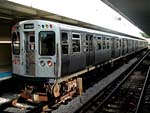
|
cta3408-TestSeats01.jpg
(169k)
Car 3408, seen here at the end of a rush hour Brown Line
train in the layup pocket at Kimball
on May 18, 2004, is one of two cars the
CTA modified with
longitudinal seating in mid-2004. (Photo by
Graham Garfield)
|
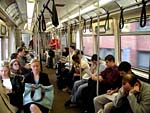
|
cta3407-TestSeats01.jpg
(196k)
Toward the end of rush hour on Monday, May 18, 2004, Brown
Line commuters are filling up nearly all the seats, with
little apparent aversion to (or awareness of) the new test
arrangement. (Photo by Graham
Garfield)
|
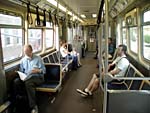
|
cta3408-TestSeats02.jpg
(172k)
By the time the test cars reach the end of the Brown Line,
as they have here on the evening of May 18, 2004, the
passenger loads tend to dissipate. Still, with plenty of
open seats on the car, passengers seem just as willing to
use the longitudinal seats as the remaining transverse ones.
(Photo by Graham Garfield)
|
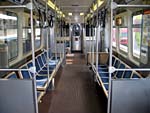
|
cta3408-TestSeats03.jpg
(157k)
While laid up at Kimball
station on May 19, 2004, the view down the aisle of car 3408
looking toward the #1 motorcab end shows how the "bowling
alley" seating provides a more open, spacious feeling car
and a wider aisle. Also note the vinyl straps hanging from
the overhead stanchions. (Photo by Kevin
Zolkiewicz)
|
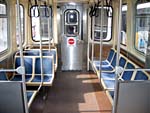
|
cta3408-TestSeats04.jpg
(144k)
At the #2 end of both cars some of the transverse seating
was left in place because its realignment wouldn't have
provided any net gain in seating or standing space, as seen
in this view inside car 3408 on May 19, 2004. Leaving some
transverse seats also provides some choice for riders who
prefer to face forward or backward. (Photo
by Kevin Zolkiewicz)
|
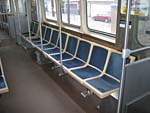
|
cta3408-TestSeats05.jpg
(135k)
This view down one side of the aisle on car 3408 on May 19,
2004 shows the general arrangement of the longitudinal test
seating. Rather than the long benches used on longitudinal
seats in the such systems as the New York subway, the test
cars used the same molded seats as a standard
CTA car. Between
every second seat is a vertical metal stanchion. Note the
under-seat equipment boxes, the nearer of which was formerly
underneath a transverse seat. (Photo by
Kevin Zolkiewicz)
|
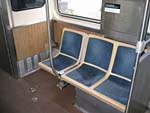
|
cta3408-TestSeats06.jpg
(153k)
Near the motorcab at the #1 end of car 3408, the transverse
seat that previously backed up against the can wall was
replaced with a single longitudinal seat, as seen on May 19,
2004. This leaves an open corner for standing (or luggage,
etc.). Note the mark on the rubber flooring where a seat was
previously mounted. The two nearest seats were always in a
longitudinal position. Besides being so arranged to
accommodate the equipment box underneath, it has been
typical of seating design since the beginning of the "L" to
make seating near the doors longitudinal to provide more
standing room near the doors where people tend to gather in
anticipation of alighting at a station.
(Photo by Kevin Zolkiewicz)
|
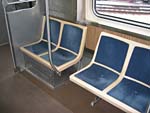
|
cta3408-TestSeats07.jpg
(146k)
Because the test longitudinal seating uses stock standard
CTA seats inside an
existing CTA car, as
well as because the existing longitudinal seats by the doors
cannot be moved in part because they cover equipment boxes,
some unusual seating gaps and other irregularities occur in
the new arrangement, as seen in car 3408 on May 19, 2004.
(Photo by Kevin Zolkiewicz)
|
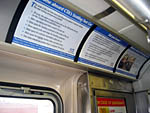
|
cta3408-TestSeats08.jpg
(142k)
To help explain to curious customers why the car they just
stepped into has such an unusual seating arrangement, the
CTA printed up
special car cards for the test unit. Replacing all interior
advertising, the three-card set is repeated through both
cars. Two of the cards explain the purpose of the car -- one
with bullet points and another with a photo -- while the
third gives some reasons for why the
CTA is engaging in
the experiment. (Photo by Kevin
Zolkiewicz)
|
|

|

|











